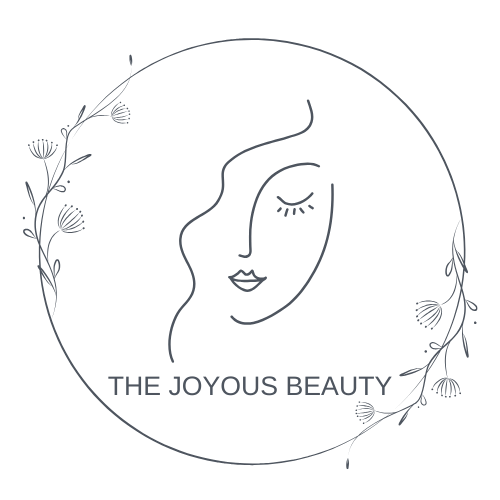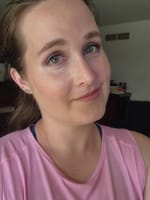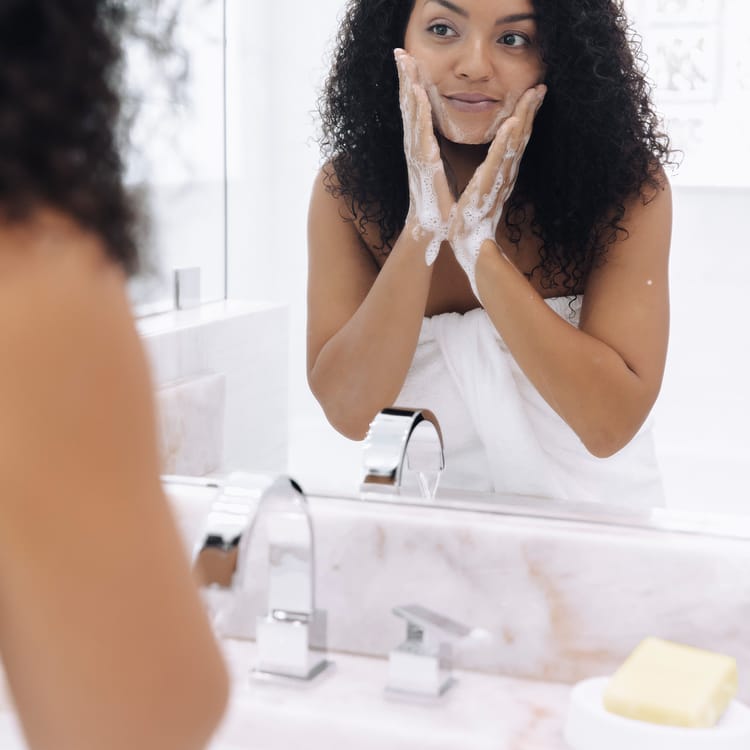5 Ingredients to Ditch in Your Everyday Beauty Products, Part 2

Author's note: Originally, I was going to condense this information into one post, but I felt that it would be unfair to you, Joyous Reader, to exclude much information that would help illuminate this discussion. This is Part Two. (Find Part One here.)
This has been a year in coming your way, so let's recap.
Remember that our investigations into what's a healthy, safe, and high performing beauty product have to go beyond terms like clean, low-tox(in), natural/all-natural, organic, non-GMO, green, vegan, cruelty-free...fill-in-the-blank. Because there is no regulation on claims made by manufacturers and brands, we have to turn the product over to discover what it actually contains. For example, a company that claims to be clean and "fragrance-free" may also have the word "fragrance (parfum)" listed among their ingredients. (Yes, sadly this is a real-world example.)
It also bears saying that, unlike in many countries, the US looks at ingredients much like it looks at its justice system: innocent until proven guilty. While this is a good strategy for law, it has not born out well in the manufacturing industries. Epigenetics is showing that the more toxins build up in our tissues, called the Bucket Effect, the worse off our health is physically, mentally, emotionally, socially, and environmentally. I would even hazard to say spiritually as well since effects on brain and body also affect our ability to believe. (1)
What is epigenetics?
Epigenetics is the study of how your lifestyle, environment, and even things like diet, stress, and exposure to toxins can affect the way your genes work — without actually changing your DNA itself.
Think of your DNA like a piano. The keys (your genes) stay the same, but epigenetics is like the sheet music that tells which keys to play, how loud, and when. Your choices and surroundings can influence which genes get "turned on" or "turned off," which can affect your health over time.
As dark as that may sound, it's also worth saying how amazing our bodies are at detoxing, or cleansing. Through elimination channels such as sweating, urination and defecation, respiration, menstruation, even crying, our bodies purge toxic build-up every day. This can result in feeling changes, such as having an energy increase or experiencing less pain and inflammation in a joint in as little as 48-72 hours. (2)
Today, let's turn our attention toward two more classes of ingredients that often get overlooked because they are not readily recognized on the label since they come in so many forms, or may be omitted from the label altogether because they are byproducts from manufacturing process.
The first has come under scrutiny in recent years, with some claiming that it is not necessary...
Category 3: Preservatives
This list is extensive and includes ingredient classes such as parabens, phenoxyethanol, BHA/BHT, methylisothiazolinone (MIT), formaldehyde and formaldehyde releasers, EDTA, and more. For a full list, see the list of Sources below.
I think it's important to begin by stating that preservatives are often found in products for a reason. Because they inhibit the growth of bacteria, mold, and yeast, preservatives are necessary and even good. We want them there. Otherwise things go bad, the resultant infection can become severe and systemic.

There are a few things to keep in mind involving the conversation surrounding preservatives. The first is that if you have water in a product, you need a preservative. No matter how pure the kind of water a manufacturer uses in a product, water introduces living compounds into a product. In order to control those from growing, a preservative is necessary. That is its primary function. (1)
Second, even anhydrous (water-free) products often contain the preservative tocopherol, a form of vitamin E. These products can be misconstrued as "preservative-free" because there is no water, which isn't often true when we begin looking at claims vs. ingredients. In fact, a lot of times, claims of "preservative-free" products may result in preservatives being hidden in the big loophole, fragrance! (Or maybe natural flavors!)
Finally, recognize that suppliers' products (single ingredients) may also contain preservatives to keep them fresh and safe for the manufacturing process. In other words, they keep the ingredient or product from deteriorating. A company may or may not know about these pre-preservatives in the raw materials data based on what the supplier or manufacturer is able to and/or chooses to disclose. Even if they do know about it, the company may not disclose it on the resultant product ingredient label that you read in the store.
The most common concerns surrounding preservatives include endocrine (hormone) disruption, increased risks of cancer, irritations and sensitivities, organ toxicity, and environmental damage. Let's look at a few of the big ones, and a few that may sneak by us unaware because they look harmless. (5, 6)
Parabens: Watch out for anything ending in -paraben. According to the Campaign for Safe Cosmetics, studies have shown that parabens can increase cell proliferation in human breast cancer MCF-7 cells, which are used as a marker for estrogenic activity. They also have been found to mimic estrogen, binding to estrogen receptors, causing hormone disruption. Furthermore, several specific types of parabens may cause harm to male reproductive health, and induce UV damage on skin cells.
BHA/BHT: Butylated compounds are found far and wide in the beauty industry. While BHA has been primarily used as an antioxidant and preservative in food, cosmetics, food preservation, and animal feed, BHT, a toluene-based ingredient, has been used mainly in food and personal care. Butylated compounds have been linked to hormone disruption, organ toxicity, developmental and reproductive toxicity, cancer, and lung irritation.
Formaldehyde: A known human carcinogen according to both the National Toxicology Program and the International Agency for Research on Cancer (IARC).
Formaldehyde releasers: These are preservatives that release small amounts of formaldehyde over time. Includes DMDM hydantoin, diazolyndinal urea, imodiazoldinal urea, quaternium-15, and bronopol.
Isothiazolinones: Cause allergic cosmetic dermatitis, and come in two main forms. Methylisothiazolinone (MIT) is one of the most predominant contact allergens found in cosmetics, and has been linked to both organ toxicity and neurotoxicity. Methylchloroisothiazolinones (CMIT/MCI) have been shown in studies to cause dermal irritation, though not as frequently as MIT.
Phenoxyethanol: Skin exposures to phenoxyethanol are linked to allergic reactions ranging from eczema and hives to anaphylaxis. Acute nervous system affects have been shown when infants are exposed to it orally. Also seen as 2-phenoxyethanol, Euxyl k 400, and PhE. (8)

And now for those that look innocent...
Essential oils: Some essential oils may contain naturally-occurring constituents, such as methyleugenol (eugenyl methyl ether) or pulegone, which may be carcinogenic and alter endocrine function.
Grapefruit seed extract: Also known as GSE. In low concentrations, it may be an ineffective preservative. It has also been found that GSE is often used in conjunction with other preservatives (i.e. parabens, triclosan) for a more efficacious perservative system, yet also increased health concerns such as respiratory irritation and endocrine disruption.
Potassium sorbate: Although it sounds natural, it may lead to eye irritation and contact dermatitis.
Vitamin E: also known as tocopherol. At high dosages, tumor formation was seen in animal studies. Dietary supplementation with vitamin E has been shown to significantly increase prostate cancer risks in healthy men.
One additional thought on preservatives. With our skin being our largest organ, the other big concern in finding a preservation system that is effective (and safe) is pH. Our skin has an optimal level of pH between 4.5-6.5. Even though preservatives could have a pH lower than 4 or higher than 10, where microorganisms cannot survive, it would likely cause our skin to react due to irritation and damage. Thus, preservatives act in a manner that makes the environment of the product inhospitable to microorganisms while maintaining the skin's natural pH. (3)
To recap, then: Within virtually all beauty products, there are preservatives that are there to balance product pH and prevent microorganisms from growing and breeding. While water is the most commonly used main ingredient in most products, even with oil-based products a preservative may get used. (If not, it may still be hiding out under the "fragrance" ingredient, or the product should be avoided altogether.)
Keep in mind, also, that even with preservatives, products do expire. Expiration dates are two-fold. For those that are unopened, there is a period after manufacturing that they maintain their efficacy. This is the primary expiration date. The secondary is called the Period After Opening, can last anywhere from 6-24 months, and is commonly found by looking for a jar symbol that contains the expiration date in months. (3)
With the clean beauty industry growing rapidly, it bears repeating that the laws governing cosmetic manufacturers has not been updated since 1938. Though there has been some strides made with efforts like MOCRA, the US is still far behind dozens of other countries that have cracked down on toxins in their beauty products, even though demand for ingredient transparency and stricter manufacturing regulations is increasing among the American public. (4)

Category 4: Ethoxylated Compounds
Also seen on the label as PEGs/PPGs (often + number), polysorbates, and compounds ending in -eth (i.e. laureth, steareth, ceteareth).
An Environmental Working Group (EWG) report focused on makeup marketed to children, found that, on their own, ethoxylated compounds hold little concern. However - don't you love that?! - the process of ethoxylation may leave behind trace amounts of carcinogens. Let's look at the two toxic contaminants linked to breast and other cancers:
1,4-dioxane: Research shows that short-term exposure can cause nausea, headache, drowsiness, and irritation of the eyes, nose, and throat. Prolonged exposure may result in dermatitis, eczema, dried and cracked skin, and liver and kidney damage. Moreover, research shows that 1,4-dioxane readily penetrates the skin. The IARC lists it as possibly carcinogenic, while Prop 65 includes it on their list of known or suspected causes of cancer and birth defects.
Ethylene oxide: A known human carcinogen according to the IARC and Prop 65, the most common cancers associated with exposure to this compound are lymphoma and leukemia. There is also some data linking it to breast cancer, and as a developmental and reproductive toxicant.
Interestingly, the preservative phenoxyethanol may also be an ethoxylated compound because, when manufactured, it reacts phenol with ethylene oxide. (It is also naturally-occurring in green tea.) The concern is that it, too, may be contaminated with 1,4-dioxane, which can be easily removed from finished products before being made available for sale, though some testing research has shown that 46% of personal care products are making it to market, suggesting that manufacturers are failing this critical step. (9, 10)
While ethoxylated compounds are listed on labels, there is really no way of knowing if a product contains residues from either contaminant. Nor does the US Food and Drug Administration (FDA) require them to be put on a label because they are considered contaminants of manufacturing.
What can we do when we find an ethoxylated compound in our favorite product? Here are three things we can do right away to reduce our exposure to ethoxylated compounds:
- I will continue to say it till I'm blue in the face: Check the label. If you see any of these, or an ingredient that you think might be one, put the product back on the shelf. Because these byproducts are believed to be harmful in any amount, I personally do not believe the risk is worth it.
- Do additional research, especially if you have a favorite product. Some companies have policies to strip contaminants, so it may be worth checking the company's website, calling and/or emailing them to see if they do have such a policy. If they give you the run around or fail to respond, drop the brand and start searching for another.
- Remember trade secret loopholes. Phenoxyethanol is also known to be a fragrance stabilizer. If you don't see it on the ingredient list, but you do see parfum/fragrance, there's a good chance an ethoxylated compound may be lurking behind the scenes.

Okay, so we've had some more bad news today, but there is a lot of good news too. Remember that our bodies were designed to eliminate toxins, and by reducing our overall body burden, we can help it heal. Here are five first steps toward doing just that!
1) Get adequate sleep. Be in bed (and ideally asleep) by 10 pm. This gives your body the time it needs to process the day, toxins, and more, in order for your tissues, issues, and mind to regenerate. (11)
2) Incorporate more colors into your meals. Yep, colorful foods are full of antioxidants that will scavenge and remove free radicals and other stressors from the body, again allowing it to heal overnight. A good rule of thumb is to incorporate every color (or at least most of them) into at least one meal per day. (11)
3) Move a little more. Count steps. Take the stairs. Get up from your desk every 45 minutes for a stretch break. Do some squats or pushups. Maybe a handstand wink, wink. Regardless of how you do it, studies have repeatedly shown that daily activity outweighs that 30-60 minutes in the gym. The more often you move, the more often you give your body the chance to move lymph, which is your immune and detox system, thereby aiding its natural junk-removal process. (11)
4) Start switching out your beauty and personal care products. This is one of the easiest areas for people to help their bodies heal, often with major, visible results quickly without huge upfront money commitments. Start with the product you use the most, or one that is spread across the largest surface area of skin. (I share my favorites and thoughts in my Facebook community!)
5) Believe that you can heal. Numerous studies show that belief is one of the main factors in beating autoimmune issues, cancers, and more. If you believe your body is amazing, you are creating an environment through biochemical response to facility the healing you crave.
Remember that detoxing your body is a process, not an event. It may take days, weeks - even months! Have patience and know that the intelligent design of your body will work!
Sources:
Preservatives
(1) Study: Cosmetics Preservation: A Review on Present Strategies
(2) University of WI Integrative Health Flyer
(3) University of MI on Preservatives
(4) EWG: The Toxic Twelve Chemicals and Contaminants in Cosmetics
(5) Campaign for Safe Cosmetics: Preservatives
(6) Campaign for Safe Cosmetics: Butylated Compounds
Ethoxylated Compounds
(7) Campaign for Safe Cosmetics: Ethoxylated Compounds
(8) Campaign for Safe Cosmetics: Phenoxyethanol
(10) Naturally Safe (AU): Phenoxyethanol
Healing through Detoxification






Comments ()